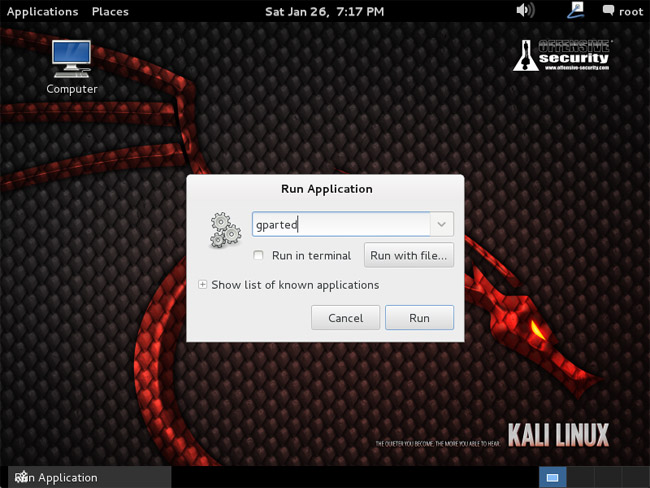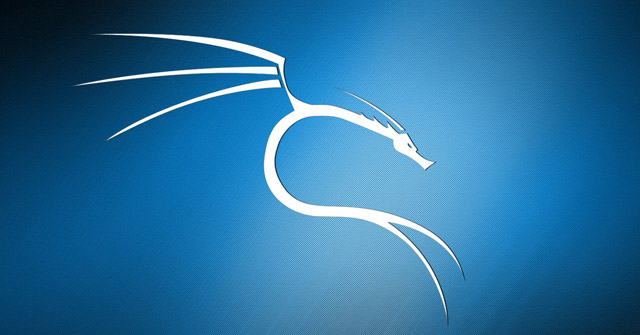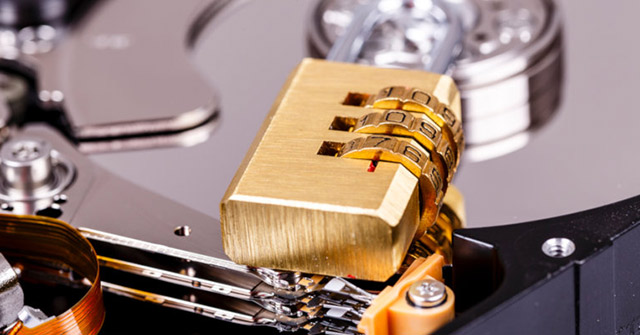How to install Kali Linux dual boot Windows
Parallel installation Kali Linux and Windows can be quite helpful. However, you need to be cautious during the setup process. First, make sure you back up any important data on your Windows installation. Because you will modify the hard drive, please store this backup on external devices. When you have finished backing up data, we recommend reading the article How to install Kali Linux on your computer - including explaining the processes for basic Kali installation.
In the following example, we will install Kali Linux and Windows 7 in parallel, currently occupying 100% of the disk space in the computer. We will start by changing the current Windows partition size to take up less space and then proceed to install Kali Linux in the newly created empty partition.
Download Kali Linux and burn ISO to DVD, or prepare a USB Kali Linux Live as the installation medium. If your computer does not have a DVD drive or USB port, check out Kali Linux installation online. Make sure you have the following:
- A minimum of 20 GB of free disk space on Windows
- Support booting CD-DVD / USB
Prepare for installation
- Download Kali Linux.
- Burn Kali Linux ISO to DVD or copy Kali Linux Live to USB.
- Make sure your computer is set to boot from the CD / USB in the BIOS.
Dual boot installation procedure - dual boot
1. To start the installation, start with the installation media you selected. You will be greeted with Kali boot screen. Choose Live , and you should boot into Kali Linux's default desktop.
2. Now, launch the generated program. We will use gparted to shrink existing Windows partitions to make room for parallel installation of Kali Linux and Windows.

3. Select your Windows partition. Depending on your system, it will usually be the second partition - larger partition. In this example, there are two partitions; The first is the System Recovery partition - System Restore and Windows are installed in / dev / sda2 . Resize your Windows partition and leave enough space (at least 20 GB) for Kali installation.

4. Once you have resized the Windows partition, make sure you select " Apply All Operations " on the hard drive. Exit gparted and restart.

Procedures for installing Kali Linux
1. The installation procedure from this point on is similar to installing Kali Linux onto the hard drive on the computer until the partition, where you need to select ' Guided - use the largest continuous free space ' that you created. previously with gparted.

2. After installation is complete, restart. You will be greeted with a GRUB boot menu, which allows you to boot into Kali or Windows.

Parallel installation of Kali Linux and Windows is now complete. It's time to customize your system.
Good luck!
See more:
- Things you need to know about Kali Linux Image
- How to create customized Potassium ISO
- How to install and use Kali Linux on VmWare virtual machine
You should read it
- Instructions for installing Kali Linux via Network PXE
- How to install Kali Linux on macOS
- How to install Kali Linux on your computer
- Things you need to know about Kali Linux Image
- How to create customized Potassium ISO
- Create dual-boot menu after installing Windows XP parallel Vista / 7
- How to install Kali Linux reduced version
- 7 risks when booting dual operating systems Windows and Linux
May be interested
- Things you need to know about Kali Linux Image
 to run 'live' potassium from a usb drive on a standard windows and apple computer, you'll need a bootable linux kali iso image, in 32-bit or 64-bit format.
to run 'live' potassium from a usb drive on a standard windows and apple computer, you'll need a bootable linux kali iso image, in 32-bit or 64-bit format. - How to update Kali Linux and fix errors when updating
 kali linux's excellent penetration testing system like any other system in the world needs to be updated. but most updates are not developed by the kali linux founding team but are created by programmers themselves.
kali linux's excellent penetration testing system like any other system in the world needs to be updated. but most updates are not developed by the kali linux founding team but are created by programmers themselves. - How to mount the hard drive and partition using the Linux command line
 if you want to use the linux terminal more, find out how to mount and remove your hard drive mount manually. this is a simple task to get started.
if you want to use the linux terminal more, find out how to mount and remove your hard drive mount manually. this is a simple task to get started. - Instructions on how to share data between Windows and Linux via LAN
 you tried using a flash drive or sd card to transfer files from linux to a windows computer and found it annoying, especially when there are too many files to move and will take a long time to complete. .
you tried using a flash drive or sd card to transfer files from linux to a windows computer and found it annoying, especially when there are too many files to move and will take a long time to complete. . - How to delete the user and the machine name in the command prompt on Terminal
 for linux users (or macs) using terminal, you will see that the default prompt will have the format [username @ hostname ~] $. please note that this is only the default setting and you can freely change it.
for linux users (or macs) using terminal, you will see that the default prompt will have the format [username @ hostname ~] $. please note that this is only the default setting and you can freely change it. - How to encrypt partitions on Linux with dm-crypt
 hard drives and ssds can be easily removed from a laptop or desktop computer. in this case, all security measures implemented by your operating system will have no idea whatsoever.
hard drives and ssds can be easily removed from a laptop or desktop computer. in this case, all security measures implemented by your operating system will have no idea whatsoever.






 How to install Kali Linux running Dual Boot with Windows
How to install Kali Linux running Dual Boot with Windows How to install Kali Linux dual boot on macOS
How to install Kali Linux dual boot on macOS Instructions for installing Kali Linux on Windows 10 are easier than ever
Instructions for installing Kali Linux on Windows 10 are easier than ever How to create USB Boot Live Kali Linux
How to create USB Boot Live Kali Linux How to install Kali Linux on macOS
How to install Kali Linux on macOS